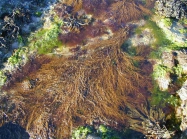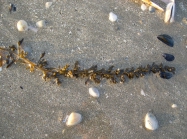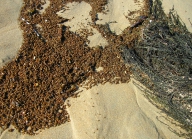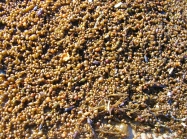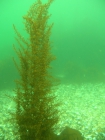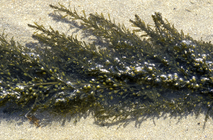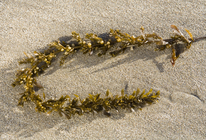WoRMS name details
Sargassum (Bactrophycus) muticum (Yendo) Fensholt, 1955
145559 (urn:lsid:marinespecies.org:taxname:145559)
alternative representation
Species
marine
(of Sargassum kjellmanianum f. muticum Yendo, 1907) Yendo, K. (1907). The Fucaceae of Japan. <em>Journal of the College of Science, Tokyo Imperial University.</em> 21: 1-174.
page(s): 104; note: as 'muticus' [details]
page(s): 104; note: as 'muticus' [details]
LSID urn:lsid:algaebase.org:taxname:77424
Distribution The Norfolk population appears to be no longer extant.
LSID urn:lsid:algaebase.org:taxname:77424 [details]
Distribution The Norfolk population appears to be no longer extant.
Distribution The Norfolk population appears to be no longer extant. [details]
Guiry, M.D. & Guiry, G.M. (2024). AlgaeBase. World-wide electronic publication, National University of Ireland, Galway (taxonomic information republished from AlgaeBase with permission of M.D. Guiry). Sargassum (Bactrophycus) muticum (Yendo) Fensholt, 1955. Accessed through: World Register of Marine Species at: https://www.marinespecies.org/aphia.php?p=taxdetails&id=145559 on 2024-04-23
Date
action
by
Copyright notice: the information originating from AlgaeBase may not be downloaded or replicated by any means, without the written permission of the copyright owner (generally AlgaeBase). Fair usage of data in scientific publications is permitted.
original description
(of Sargassum kjellmanianum f. muticum Yendo, 1907) Yendo, K. (1907). The Fucaceae of Japan. <em>Journal of the College of Science, Tokyo Imperial University.</em> 21: 1-174.
page(s): 104; note: as 'muticus' [details]
basis of record Guiry, M.D. & Guiry, G.M. (2023). AlgaeBase. <em>World-wide electronic publication, National University of Ireland, Galway.</em> searched on YYYY-MM-DD., available online at http://www.algaebase.org [details]
basis of record Guiry, M.D. (2001). Macroalgae of Rhodophycota, Phaeophycota, Chlorophycota, and two genera of Xanthophycota, <B><I>in</I></B>: Costello, M.J. <i>et al.</i> (Ed.) (2001). <i>European register of marine species: a check-list of the marine species in Europe and a bibliography of guides to their identification. Collection Patrimoines Naturels,</i> 50: pp. 20-38 (look up in IMIS) [details]
additional source Muller, Y. (2004). Faune et flore du littoral du Nord, du Pas-de-Calais et de la Belgique: inventaire. [Coastal fauna and flora of the Nord, Pas-de-Calais and Belgium: inventory]. <em>Commission Régionale de Biologie Région Nord Pas-de-Calais: France.</em> 307 pp., available online at http://www.vliz.be/imisdocs/publications/145561.pdf [details]
additional source Streftaris, N., A. Zenetos & E. Papathanassiou. (2005). Globalisation in marine ecosystems: the story of non-indigenous marine species across European seas. <em>Oceanogry and Marine Biology: an Annual Review.</em> 43: 419-453. (look up in IMIS) [details] Available for editors [request]
[request]
additional source Eno, N. C.; Clark, R. A.; Sanderson, W. G. (1997). Non-native marine species in British waters: a review and directory. <em>Joint Nature Conservation Committee, Peterborough.</em> pp. 136. (look up in IMIS) [details] Available for editors [request]
[request]
page(s): 104; note: as 'muticus' [details]
basis of record Guiry, M.D. & Guiry, G.M. (2023). AlgaeBase. <em>World-wide electronic publication, National University of Ireland, Galway.</em> searched on YYYY-MM-DD., available online at http://www.algaebase.org [details]
basis of record Guiry, M.D. (2001). Macroalgae of Rhodophycota, Phaeophycota, Chlorophycota, and two genera of Xanthophycota, <B><I>in</I></B>: Costello, M.J. <i>et al.</i> (Ed.) (2001). <i>European register of marine species: a check-list of the marine species in Europe and a bibliography of guides to their identification. Collection Patrimoines Naturels,</i> 50: pp. 20-38 (look up in IMIS) [details]
additional source Muller, Y. (2004). Faune et flore du littoral du Nord, du Pas-de-Calais et de la Belgique: inventaire. [Coastal fauna and flora of the Nord, Pas-de-Calais and Belgium: inventory]. <em>Commission Régionale de Biologie Région Nord Pas-de-Calais: France.</em> 307 pp., available online at http://www.vliz.be/imisdocs/publications/145561.pdf [details]
additional source Streftaris, N., A. Zenetos & E. Papathanassiou. (2005). Globalisation in marine ecosystems: the story of non-indigenous marine species across European seas. <em>Oceanogry and Marine Biology: an Annual Review.</em> 43: 419-453. (look up in IMIS) [details] Available for editors
additional source Eno, N. C.; Clark, R. A.; Sanderson, W. G. (1997). Non-native marine species in British waters: a review and directory. <em>Joint Nature Conservation Committee, Peterborough.</em> pp. 136. (look up in IMIS) [details] Available for editors
 Present
Present  Present in aphia/obis/gbif/idigbio
Present in aphia/obis/gbif/idigbio  Inaccurate
Inaccurate  Introduced: alien
Introduced: alien  Containing type locality
Containing type locality
From editor or global species database
LSID urn:lsid:algaebase.org:taxname:77424 [details]From other sources
Distribution The Norfolk population appears to be no longer extant. [details]alien species The Japanese sargasso weed or strangleweed Sargassum (Bactrophycus) muticum naturally thrives along the coasts of Japan, Russia, Korea, and China. This brown alga was imported in Europe together with Japanese oysters (either directly from Asia or with infected Canadian oyster breed). Strangleweed has been washing ashore along the Belgian coast regularly since the seventies. The first specimens - attached to hard substrate - were discovered in the harbor of Zeebrugge, in 1999. In areas where strangleweed has successfully invaded, it outcompetes the indigenous species by its fast growth. This is however not the case in Belgium. Floating packages of this seaweed however contribute to a rich community of marine organisms that use it as a food source, shelter, foraging area or attachment surface. [details]
| Language | Name | |
|---|---|---|
| Dutch | Japans bessenwier | [details] |
| English | wireweedstrangleweedJapweedJapanese sargasso weed | [details] |
| French | sargasse Japonaise | [details] |
| German | Japanischer Beerentang | [details] |
